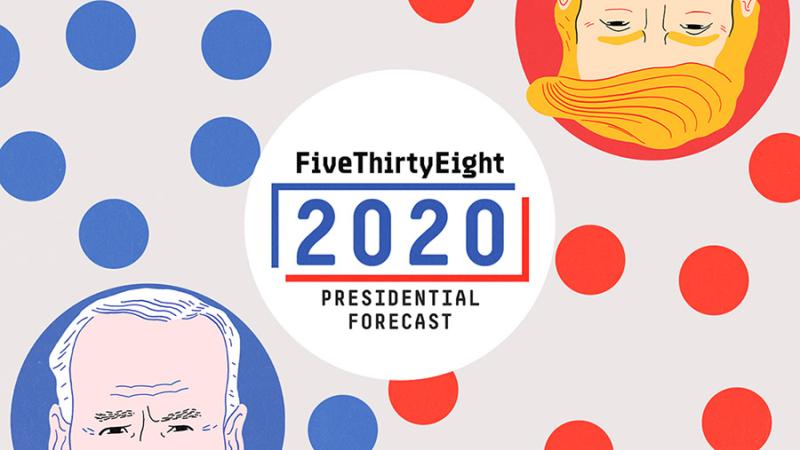2020 Election Forecast | FiveThirtyEight



Oct. 23, 2020
Thursday marked the final presidential debate, and the question now is will the race tighten? President Trump is simply running out of time to mount a comeback and Joe Biden has a hefty lead in national and state polls. We're now in the home stretch before Election Day, and we're way past the point where a normal polling error could let Trump close the gap. Still, he has a meaningful chance per our forecast — a little worse than the chances of rolling a 1 on a six-sided die and a little better than the chances that it's raining in downtown Los Angeles. And remember, it does rain there. (Downtown L.A. has about 36 rainy days per year, or about a 1-in-10 shot of a rainy day.)
- Want to test out our forecast and see what happens if Trump wins Florida or Biden wins Texas? Well, now you can! We've built an interactive forecast that lets you explore the ways Trump or Biden could win the election. But there are limits. (Yes, we've seen the Fivey memes.) If Biden or Trump has less than a 1.5 percent chance of winning a state, you can't select that candidate, as ultimately we're hoping you'll use this tool to explore some very plausible scenarios. That's certainly how we plan to use it in the lead-up to the election — and beyond if it's not clear who the winner is on election night.
- The last two weeks of the campaign can be an incredibly stressful time, so editor-in-chief Nate Silver offers eight tips to stay sane, including paying attention to polling averages (not individual polls) and not putting too much stock in how either campaign "feels" (they usually do not have a better read on the race than the polls).
2020 Election Coverage
What Would Democrats Do If They Controlled Congress And The White House?
By Clare Malone
Polling 101: What Happened To The Polls In 2016 — And What You Should Know About Them In 2020
By Dhrumil Mehta, Michael Tabb and Anna Rothschild
To put all these numbers in context, check out our coverage and subscribe to the FiveThirtyEight Politics podcast!
We simulate the election 40,000 times to see who wins most often. The sample of 100 outcomes below gives you a good idea of the range of scenarios our model thinks is possible.
Trump win Biden win
No Electoral College majority, House decides election Don't count the underdog out! Upset wins are surprising but not impossible.
Every outcome in our simulations
All possible Electoral College outcomes for each candidate, with higher bars showing outcomes that appeared more often in our 40,000 simulations
More bars to the right of the 270 line means more simulations where that candidate wins. Some of the bars represent really weird outcomes, but you never know!
The winding path to victory
States that are forecasted to vote for one candidate by a big margin are at the ends of the path, while tighter races are in the middle. Bigger segments mean more Electoral College votes. Trace the path from either end to see which state could put one candidate over the top.
Vote Margins Tipping Points Maine and Nebraska's congressional districts are shown separately because those states split their Electoral College votes, allotting some to the statewide winner and some to the winner of each district. We call this the snake chart! This makes it easy to see why some states are hotly contested and others mostly get ignored.
How the forecast has changed
The forecast updates at least once a day and whenever we get a new poll. Click the buttons to see the ways each candidate's outlook has changed over time.
Chance of winning Electoral votes Popular vote Win chance Elec. coll. Pop. vote As the election gets closer — and as we get swamped with new polls — the forecast will get less uncertain.
Weird and not-so-weird possibilities
The chances that these situations will crop up
Who's ahead in national polls?
Our model relies mainly on state polls, which it combines with demographic, economic and other data to forecast what will happen on Election Day. If you want to see a snapshot of what voters are thinking right now — with no fancy modeling — check out the national polls.
See our national polling averages




I'm not sure how or why 538 became the media darling, but it should be remembered the 2016 forecast had 82-18 for Clinton. Granted 538 was showing a narrowing of the gap at eleven days prior to election, but then an widening just before. I always figured the media fascination with 538 was part of Clinton's demise. Dave Liep indicated a dramatic tightening of the race in 2016.
Liep's data indicates Biden has been above the 270 threshold since May and Trump has consistently been in the 140 range. Even if Trump were to win all the undecided, the number comes up short. North Carolina and Arizona are leaning for Biden and the states making up the 279 currently in the barn... have wide margins in favor of the dems.
The debate didn't get the same amount of viewers as the first or second "debate/town halls,
while even Thursday Night Football between 2 teams with 2 wins and 9 losses
had 10.7 million viewers.
Sad state of affairs.